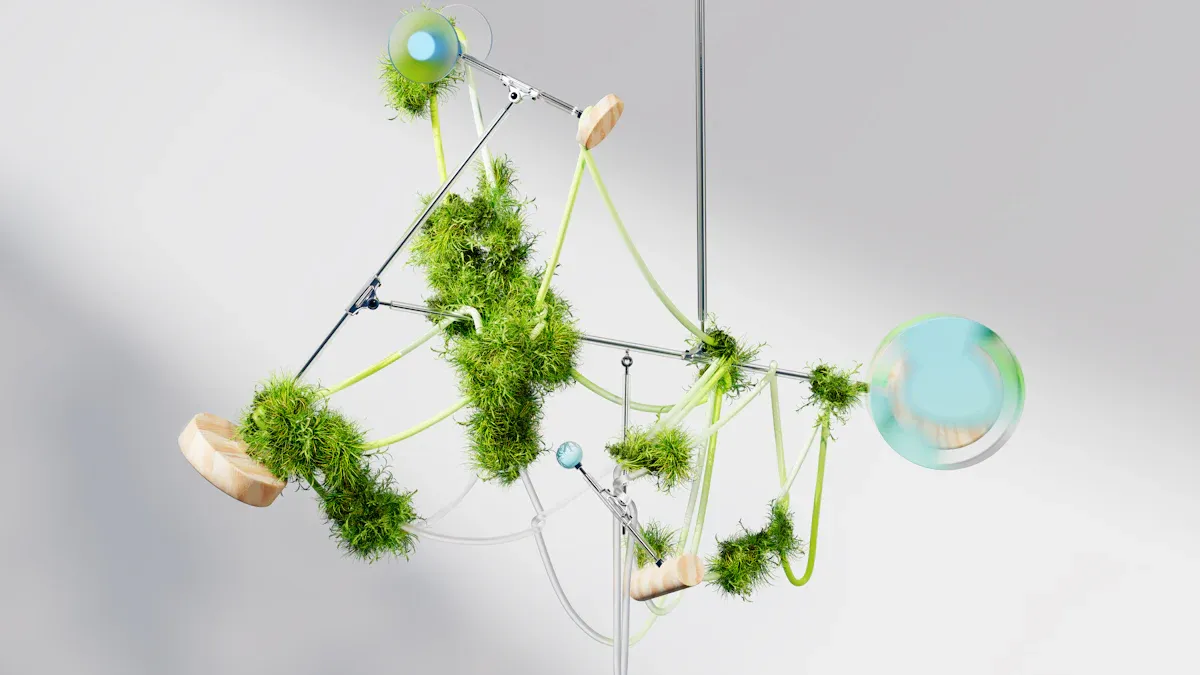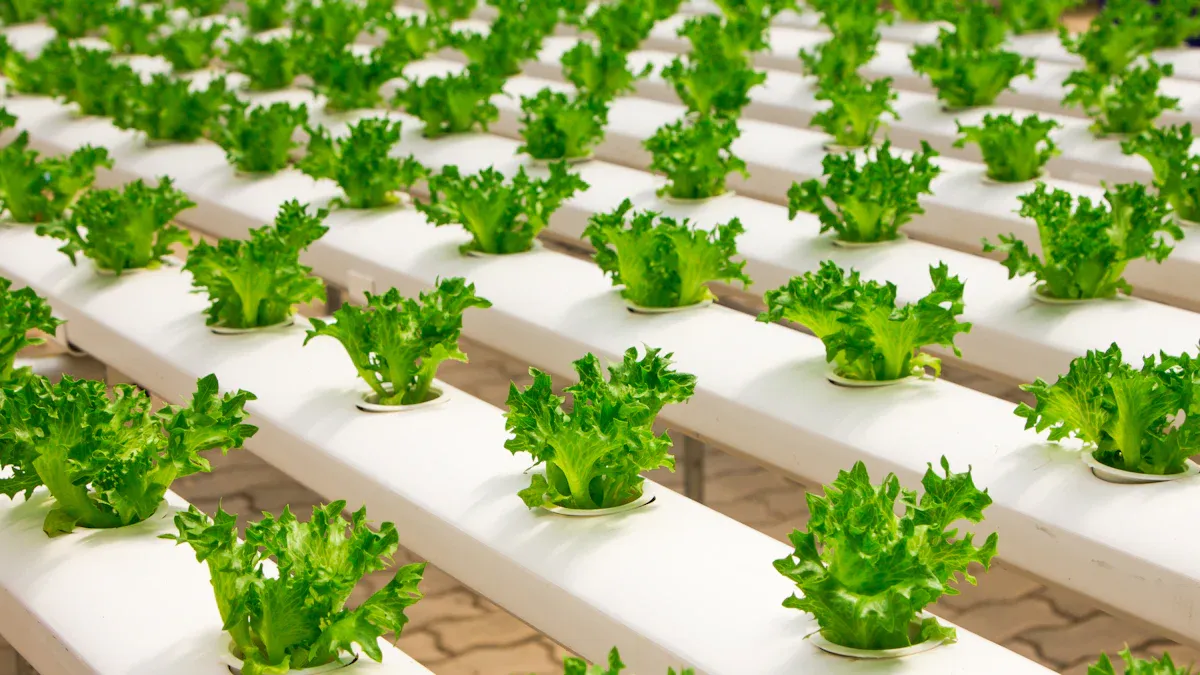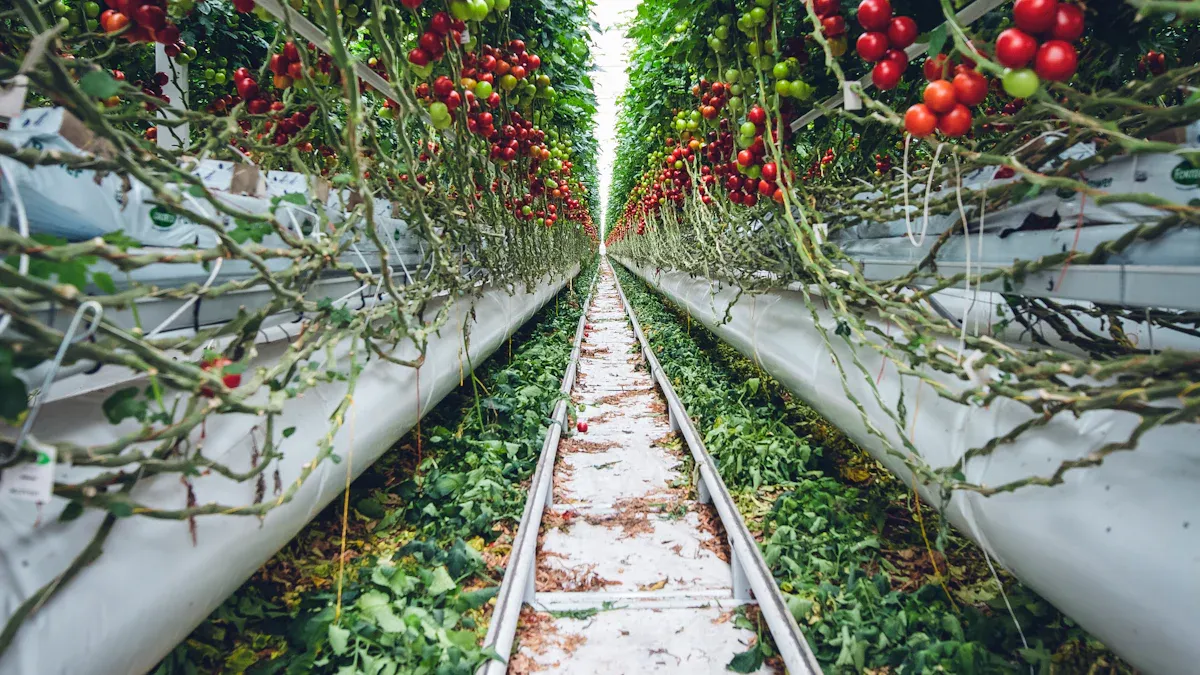
Aeroponics is an innovative growing method that allows you to cultivate plants without soil. In this system, roots hang in the air and receive a fine mist of nutrients. This technique not only maximizes space but also enhances growth rates. For instance, aeroponics can yield approximately 40-70 kg of produce per square meter, which is about 300% higher than conventional farming’s average of 10-20 kg. As you explore the world of modern agriculture, you’ll find that aeroponics stands out for its efficiency and sustainability.
Key Takeaways
Aeroponics allows plants to grow without soil, using a mist of nutrients that promotes faster growth and healthier roots.
This method uses up to 95% less water than traditional farming, making it a sustainable choice for urban agriculture.
Aeroponic systems can yield 25-35% more crops compared to conventional methods, maximizing harvest frequency and quality.
Aeroponics reduces the need for pesticides and fertilizers, leading to a lower environmental impact and healthier produce.
The technology is suitable for both commercial farming and home gardening, providing flexibility in food production.
Aeroponics Overview

Key Features
Aeroponics is a unique method of growing plants without soil. Here are some defining characteristics that set it apart:
No Substrate: Unlike hydroponics, where plants grow in nutrient-rich water, aeroponics suspends roots in the air. This allows for better oxygen access and promotes healthier root development.
Misting System: Aeroponics delivers nutrients through a fine mist or atomized solution. This method enhances the aerobic environment for plants and significantly reduces water usage by up to 60%.
Space Efficiency: You can grow more plants in a smaller area. This makes aeroponics ideal for urban settings where space is limited.
Reduced Resource Use: Aeroponics minimizes the need for pesticides and fertilizers, leading to a lower environmental impact compared to traditional farming.
Historical Context
The concept of aeroponics has evolved over time. Here are some key milestones in its development:
The term “aeroponics” was coined by Frits Warmolt Went in 1957, marking the beginning of this innovative growing method.
In 1983, Richard Stoner filed his first aeroponic patent and founded Genesis Technology Incorporated. This company developed the first commercial-scale aeroponic systems, known as the Genesis Machine.
NASA’s involvement in aeroponics began with experiments on the MIR space station in 1997. These studies demonstrated that plants grown in microgravity exhibited more growth than those on Earth.
Stoner’s research has also been utilized on the International Space Station, showcasing the technology’s relevance in both commercial and space applications.
Aeroponics stands out when compared to traditional soil-based agriculture and hydroponics. The following table summarizes the main differences:
Method | Soil Usage | Water Usage | Growth Environment | Nutrient Delivery | Environmental Impact |
|---|---|---|---|---|---|
Aeroponics | No | Minimal | Air and mist | High-pressure mist | Very low |
Hydroponics | No | Low | Controlled | Submerged roots | Low |
Traditional Soil | Yes | High | Natural | Soil-based | Higher |
As you can see, aeroponics uses significantly less water than both hydroponics and traditional soil-based agriculture. This efficiency makes it a promising solution for sustainable farming practices.
How the Aeroponic System Works
System Components
To understand how an aeroponic system functions, you need to know its essential components. Here’s a list of what you will typically find in a well-designed aeroponic setup:
A building (like a greenhouse) for growing plants, if necessary
A reservoir tank to hold the nutrient solution
A pump or pressurized tank to create mist
Misters that spray the nutrient-rich mist onto the roots
Pipes and tubing to transport the mist
Pots or trays to hold the plants
Towers or racks to maximize vertical space
A timer to control misting intervals
These components work together to create an optimal environment for plant growth. The absence of soil allows for better oxygen access, which is crucial for healthy root development.
Nutrient Delivery
The nutrient delivery process in an aeroponic system is one of its standout features. It uses a nutrient-dense mist to provide plants with essential nutrients. Here’s how it works:
Mechanism/Parameter | Description |
|---|---|
Pressure | Significant pressure (exceeding 65 psi) is required to penetrate dense root systems effectively. |
Droplet Size | Maintaining appropriate hydro-atomized droplet size is crucial for nutrient delivery efficiency. |
Nutrient Bioavailability | Higher pressure increases nutrient bioavailability, necessitating reduced nutrient strength to avoid plant damage. |
Feed/Pause Cycle | Optimal cycles involve short feeding (less than 2 seconds) followed by longer pauses (1.5-2 minutes) to keep roots slightly damp. |
Flexibility of Nutrient Delivery | Aeroponics allows for precise control over nutrient solutions without needing to flush previous ones, enabling tailored nutrient regimens. |
This method of nutrient delivery offers several benefits. For instance, aeroponics can lead to up to 30% faster growth compared to traditional methods. It uses up to 95% less water, making it incredibly efficient. The enhanced nutrient absorption occurs because the roots have maximum access to oxygen, which is not possible in submerged systems like hydroponics.
In addition, aeroponic systems are designed to be relatively pest-free. Since plants do not come into direct contact with soil, the risk of soil-borne diseases decreases significantly. This controlled environment helps you manage pests more effectively, reducing the need for pesticides.
Overall, the combination of these components and the nutrient delivery process makes aeroponics a revolutionary method for growing plants. It not only maximizes growth potential but also promotes sustainability in agriculture.
Benefits of Aeroponics
Resource Efficiency
Aeroponics offers remarkable resource efficiency, especially in terms of land and water usage. Here are some key points:
Land Savings: Aeroponics utilizes a soil-less cultivation method. This approach allows for more efficient land use compared to traditional farming. In urban areas, where land is limited, aeroponics can be particularly beneficial.
Water Savings: Aeroponic systems demonstrate greater water use efficiency than hydroponic systems. They can reduce water usage by up to 98%. This efficiency improves with the use of more nozzles in the aeroponic setup. You can grow plants with minimal water, making it a sustainable choice.
Growth Rates
Aeroponics significantly enhances growth rates. You can expect the following benefits:
Increased Harvest Frequency: Aeroponic setups allow for year-round cropping cycles. This means you can harvest more often, maximizing your yield.
Higher Yields: Studies show that aeroponic systems can improve yields by 25-35% for various vegetable crops. Enhanced nutrient availability and environmental control contribute to this increase. You will notice healthier crops with consistent quality.
Environmental Impact
Aeroponics has a positive environmental impact. Here’s how:
Reduced Runoff: Aeroponics uses 95% less water compared to traditional farming. This reduction significantly decreases agricultural runoff, which can pollute waterways.
Lower Energy Demands: The system requires minimal power for operation. The pump runs for only short intervals, reducing energy consumption. This efficiency helps lower greenhouse gas emissions.
Urban Farming Benefits: Aeroponic systems promote urban farming. They create green spaces that improve air quality by absorbing CO2 and releasing oxygen. Additionally, these systems can filter airborne particulates, contributing to cleaner air.
Current Applications of Aeroponics

Commercial Farming
Aeroponics has made significant strides in commercial farming. You can find large-scale aeroponic farms that produce vast quantities of crops. For instance, one of the largest commercial aeroponic farms is located in Danville, Virginia. This farm boasts an annual production capacity of over 3 million pounds of leafy microgreens. It serves over 50 million people within a day’s drive. Notably, it reduces water usage by up to 95% compared to traditional farming methods. This efficiency not only conserves resources but also creates jobs, adding 158 positions to the local economy. Here’s a quick overview of this impressive operation:
Feature | Details |
|---|---|
Location | Danville, Virginia |
Annual Production Capacity | Over 3 million pounds of leafy microgreens |
Service Area | Over 50 million people within a day’s drive |
Water Usage Reduction | Up to 95% less water than traditional farming |
Employment Impact | 158 jobs added to the local economy |
Technology Used | Proprietary indoor vertical farming technology |
Certifications | USDA Good Agricultural Practices, SQF Level 2, Non-GMO Project Verification, OU Kosher, CEA Food Safety Seal |
Common crops grown in these commercial settings include:
Kale
Broccoli
Brussel sprouts
Urban Agriculture
Aeroponics is also transforming urban agriculture. You can see initiatives in major cities that utilize aeroponic techniques to grow food in limited spaces. For example, the Parisculteurs initiative aims to green 250 acres of urban space in Paris through aeroponic farming and rooftop agriculture. This project emphasizes environmental and biodiversity goals. Here’s a brief look at how aeroponics fits into urban agriculture:
Initiative | Description |
|---|---|
Aeroponics | A technique that involves growing plants in an air or mist environment without soil, using less water and suitable for urban spaces. |
The benefits of aeroponics for urban food production include:
Benefit | Description |
|---|---|
Water Efficiency | Aeroponics uses significantly less water than traditional methods. |
Nutrient Absorption | Superior absorption of nutrients due to increased oxygen exposure. |
Reduced Pathogen Risk | Lower risk of soil-borne pathogens as soil is not used. |
Research and Development
Research institutions play a crucial role in advancing aeroponic technology. You can find universities conducting trials to improve aeroponic practices. For instance, Wageningen University collaborates with LettUs Grow to evaluate different irrigation systems. This partnership enhances the understanding of aeroponics. Other notable contributions include:
The Taeda Tech project at the University of Surrey focuses on sustainable propagation of woody crops.
Charleston Southern University offers a hands-on aeroponics class led by Dr. Thomas Gurley, fostering innovation in the field.
Recent breakthroughs in aeroponics technology include:
Date | Advancement Description |
|---|---|
October 2024 | LettUs Grow launched the Aeroponic Rolling Bench, enhancing productivity for large-scale indoor growers. |
April 2024 | LettUs Grow partnered with Innovative Growers Equipment to introduce ultrasonic aeroponics to greenhouse growers in the U.S. and Canada. |
February 2024 | LettUs Grow announced a partnership program to enhance the global reach of its ultrasonic aeroponic technology. |
January 2023 | CleanGreens Solutions S.A. signed a contract to install a 3,500 square meter aeroponic project, allowing local production of aromatic herbs. |
May 2025 | LettUs Grow partnered with KG Systems to integrate advanced aeroponics technology across KG Systems’ international operations. |
Government policies also support the adoption of aeroponics. These can include subsidies, research grants, and integration into existing agricultural networks. Such measures enhance food security and support farmers.
Aeroponics represents a groundbreaking shift in how you can grow food. This method offers numerous advantages, including:
Reduced water usage, recycling water efficiently.
Higher yield potential due to improved nutrient delivery.
Scalability, making it suitable for urban farming.
A study in the UK shows that aeroponic systems can produce food with lower environmental impacts than traditional farming. By harnessing renewable energy, these systems can significantly reduce carbon emissions and enhance food security. Embracing aeroponics can lead to a more sustainable future in agriculture.
FAQ
What plants can you grow using aeroponics?
You can grow a variety of plants using aeroponics, including leafy greens like lettuce, herbs like basil, and even fruits like strawberries. Many commercial farms focus on high-demand crops that thrive in this system.
How much water does an aeroponic system use?
Aeroponic systems use up to 95% less water than traditional farming methods. This efficiency comes from the misting technique, which delivers nutrients directly to the roots without excess runoff.
Is aeroponics suitable for home gardening?
Yes, aeroponics is suitable for home gardening. You can set up small systems indoors or outdoors. They require minimal space and can yield fresh produce year-round.
What are the initial costs of setting up an aeroponic system?
Initial costs vary based on system size and complexity. A basic home setup may start around $100, while larger commercial systems can cost thousands. Consider your budget and goals when planning.
How does aeroponics compare to hydroponics?
Aeroponics differs from hydroponics in that it suspends roots in air and uses a mist for nutrient delivery. This method allows for better oxygen access and often results in faster growth rates.

